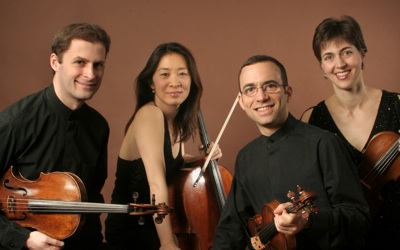Mixing new and old, Brentano Quartet foments a reverent rebellion
Musical and poetic fragments draw us inside the creative process, a gestation rich in possibility. And when those fragments are from great composers, they possess a lure like the greatest unsolved mathematical problems. The Brentano String Quartet celebrated its twentieth anniversary by asking six contemporary composers to write new fragments based on six unfinished works. San Francisco Performances brought the Brentano Quartet to Herbst Theatre on Sunday, Dec 4, to hear the culmination of this project.
They began with New York composer Charles Wuorinen, who used two movements intended for the Catholic Mass by Josquin and Dufay, French Renaissance composers. He interwove and overlaid their material with his own, letting their lovely polyphonies slowly erode into more modern material. The fifteenth century church modal phrases began to slip out of tune, until all four instruments were bending notes into a complex and surprisingly danceable line.
After that came a timeless treat, Franz Schubert’s Quartet in C minor, the “Quartettsatz,” which is often performed even though it consists of a single movement. Stepping outside of the intent of the project, this was our chance to hear the Brentano quartet strut through a Romantic masterpiece. Rather than effusive passion, they gave a reading that was delicate, simply phrased and even-handed. While some quartets squabble over solos, and others balance the sting of one queen bee with the hard work of three drones, the Brentano’s approach was far more that of colleagues, allowing us to enjoy the riches of the inner lines. In that, Serena Canin illuminated the harmonies from within, playing the lower second violin line, and Misha Amory brought a sturdy presence to the viola part.
After the soaring first violin passages, which Mark Steinberg tended with sweetness and restraint, came a section of “rumble strips,” smooth sailing alternating with sudden dense tremolos.
 They moved into Schubert’s incomplete next movement, stopping after a moment where the composer had stopped, then continued with Fra(nz)g-mentation, composer Bruce Adolphe’s response. Nina Maria Lee’s cello solo took a yearningly romantic phrase and built it into the backbone of a minimalist treatment. That phrase moved around the foursome, then decayed into single notes and wind-blown harmonies. It was impressive to hear Adolphe decant the material into a modern mold, with his off-kilter 11-beat rhythms creating surprising depth.
They moved into Schubert’s incomplete next movement, stopping after a moment where the composer had stopped, then continued with Fra(nz)g-mentation, composer Bruce Adolphe’s response. Nina Maria Lee’s cello solo took a yearningly romantic phrase and built it into the backbone of a minimalist treatment. That phrase moved around the foursome, then decayed into single notes and wind-blown harmonies. It was impressive to hear Adolphe decant the material into a modern mold, with his off-kilter 11-beat rhythms creating surprising depth.
They moved back in time to J. S. Bach, giving a lovely rendition of his unfinished Contrapunctus XVIII, and bringing out the essential wonder and mystery of Bach: that he could freight his mathematical purity with such deep feeling.
Noted Russian composer Sofia Gubaidulina took Bach’s theme, a four-note play on his own name, B-A-C-H (in German, “H” is B natural), and created an almost painfully stretched-out work with plastic harmonies, withered notes and deep silences. They attempted the fugue phrase, stopped, and then tried again, this time climbing up into stratospheric harmonics before falling back down to low cello scrabbling, then ended on four slow chords, the “Bach” theme. Despite her post-modern structure, Gubaidulina grabbed for the spiritual, paralleling the essence of Bach’s fugue.
After intermission came three more pairings, derived from Haydn, Shostakovich, and Mozart. Written near the end of a fruitful life, Haydn’s Quartet in D minor, Op. 103, consisted of two movements, rather than the full four. 74-year-old composer John Harbison reflected in our program notes on what it is to continue to work into one’s seventies, the age when Haydn stopped writing, and his response to Haydn was a high point among the six excellent offerings.
Complex rhythmic cadences gave rise to a sense that we were among a flock of birds, chatting amiably about order and disorder. Harbison found a careful balance between each individual’s line and response to the others, re-creating Haydn’s mastery of “friendly discourse,” the soul of a string quartet. Peaks were etched in with sharp unisons, while deftly woven dissonances shaped Harbison’s spangled fabric. This was a marvelous work, though of artistic necessity a fragment, and one hopes that it will find a permanent place.
Stephen Hartke chose Shostakovich as his springboard, and he certainly had the propulsive force of the source material, if not the bitterness. Indeed, his wild runs were almost lyrical where Shostakovich’s slower pace was acidic. Hartke chose a viola’s mid-range to balance the intensity of his writing, which Amory delivered sotto voce, before the other three joined the fray. The cello’s soft strokes mimicked the Russian’s trudging rhythms, then built as they climbed to a punishingly high exchange.
Finally, Mozart got his due, with his Quartet fragment in E Minor stuttering to a false stop in Vijay Iyer’s humorous treatment. Iyer wrote of wrestling with the feeling that he was treading on holy ground: “For a composer to be tasked with finishing an unfinished piece by Mozart is to serve as the punch line to a joke.” But he gamely tackled the impossible, first giving each string its own time signature, and then adding modern rock rhythms to the classical work. Iyer’s update thrusts the fugue into modern parlance, no easy task. But, as he predicted, it falls short of Mozart’s melodic genius.
San Francisco Performances, one of the Bay Area’s largest presenters, does the simply beautiful along with the more adventurous. Information on their many events, including chamber music, recitals, dance and jazz is available at sfperformances.org.
—Adam Broner
Photo of Brentano String Quartet, from left: Misha Amory, viola, Nina Maria Lee, cello, Mark Steinberg and Serena Canin, violins. Photo by Peter Schaaf.
